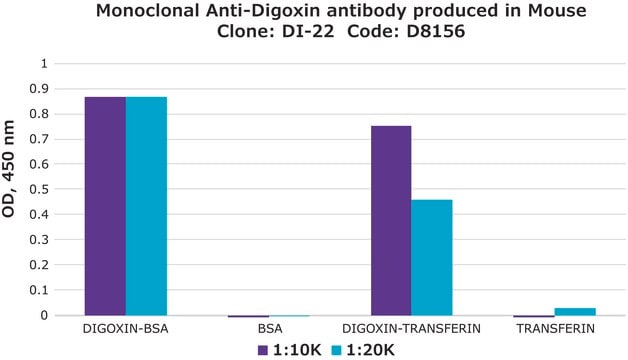11207750910
Roche
Anti-Digoxigenin-Rhodamine, Fab fragments
from sheep
Synonym(s):
anti-digoxigenin, digoxigenin
About This Item
Recommended Products
biological source
sheep
Quality Level
conjugate
rhodamine conjugate
antibody form
purified antibody
antibody product type
primary antibodies
clone
polyclonal
form
lyophilized (clear, red solution after reconstitution)
packaging
pkg of 200 μg
manufacturer/tradename
Roche
isotype
IgG
storage temp.
2-8°C
General description
Specificity
Application
- Digoxigenin-labeled sugars in glycoconjugate research
- Fluorescent in situ hybridization (FISH)
- Immunohistocytochemistry
- In situ hybridization
- DNA fiber assay
Preparation Note
Working concentration: Working concentration of conjugate depends on application and substrate. The following concentrations should be taken as a guideline: Detection of digoxigenin-labeled sugars in glycoconjugates: 20 to 50 μg/ml
- Fluorescent in situ hybridization (FISH): 1 to 20 μg/ml
- Immunohistocytochemistry: 20 to 50 μg/ml
- In situ hybridization: 20 to 50 μg/ml
Working solution: PBS, 0.5% bovine serum albumin (w/v), pH 7.4.
1% Blocking reagent (w/v), 1 to 5% heat inactivated fetal calf serum (v/v) or sheep normal serum can be used for reduction of unspecific binding. Furthermore pH can be increased up to pH 8.5 to 9.0.
Storage conditions (working solution): Always prepare fresh!
Reconstitution
Other Notes
Not finding the right product?
Try our Product Selector Tool.
Signal Word
Warning
Hazard Statements
Precautionary Statements
Hazard Classifications
Aquatic Chronic 3 - Skin Sens. 1
Storage Class Code
11 - Combustible Solids
WGK
WGK 2
Flash Point(F)
does not flash
Flash Point(C)
does not flash
Certificates of Analysis (COA)
Search for Certificates of Analysis (COA) by entering the products Lot/Batch Number. Lot and Batch Numbers can be found on a product’s label following the words ‘Lot’ or ‘Batch’.
Already Own This Product?
Find documentation for the products that you have recently purchased in the Document Library.
Customers Also Viewed
Articles
Digoxigenin (DIG) labeling methods and kits for DNA and RNA DIG probes, random primed DNA labeling, nick translation labeling, 5’ and 3’ oligonucleotide end-labeling.
Our team of scientists has experience in all areas of research including Life Science, Material Science, Chemical Synthesis, Chromatography, Analytical and many others.
Contact Technical Service






